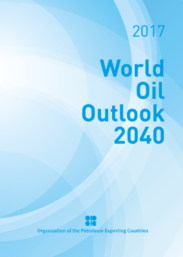
2017: World Oil Outlook 2040

Since the publication of the World Oil Outlook (WOO) 2016 in November last year the market has experienced significant changes that have had an impact on medium- and long-term estimates. This is particularly evident from the supply viewpoint, with OPEC’s decisions taken in Algiers (28 September 2016) at the 170th (Extraordinary) Meeting of the OPEC Conference and then in Vienna (30 November 2016) at the 171st Meeting of the OPEC Conference, seeing its Member Countries implement a production adjustment with a target of 32.5 million barrels a day (mb/d) with effect from 1 January 2017. Moreover, the subsequent OPEC and nonOPEC Declaration of Cooperation through the Ministerial Meetings in Vienna (10 December 2016 and 25 May 2017) embraced a production adjustment of 1.2 mb/d for OPEC, together with a production adjustment of around 0.6 mb/d from participating non-OPEC producing countries. The decisions were focused on accelerating the ongoing drawdown of the stock overhang, which is now well underway, as a means to help bring the oil market rebalancing forward. Future developments in energy and oil markets will be driven by number of factors. The critical ones include population growth, changing demographics, the assumed path of economic growth, policy changes, technology advancements and energy and oil prices. For population growth, this is expected to expand at an unprecedented low rate compared to the previous century. Moreover, the growth rate is anticipated to see a further deceleration as the outlook moves to 2040. At the same time, the world continues to age as fertility rates decline and people live longer across the world. In addition, more people are moving from country-to-country, as well as increasingly to urban areas.
- Issues:
- Energy, Climate Change, Economics
- Region:
- Global
- Year Published:
- 2017
- Institution:
- Organization of the Petroleum Exporting Countries (OPEC)

